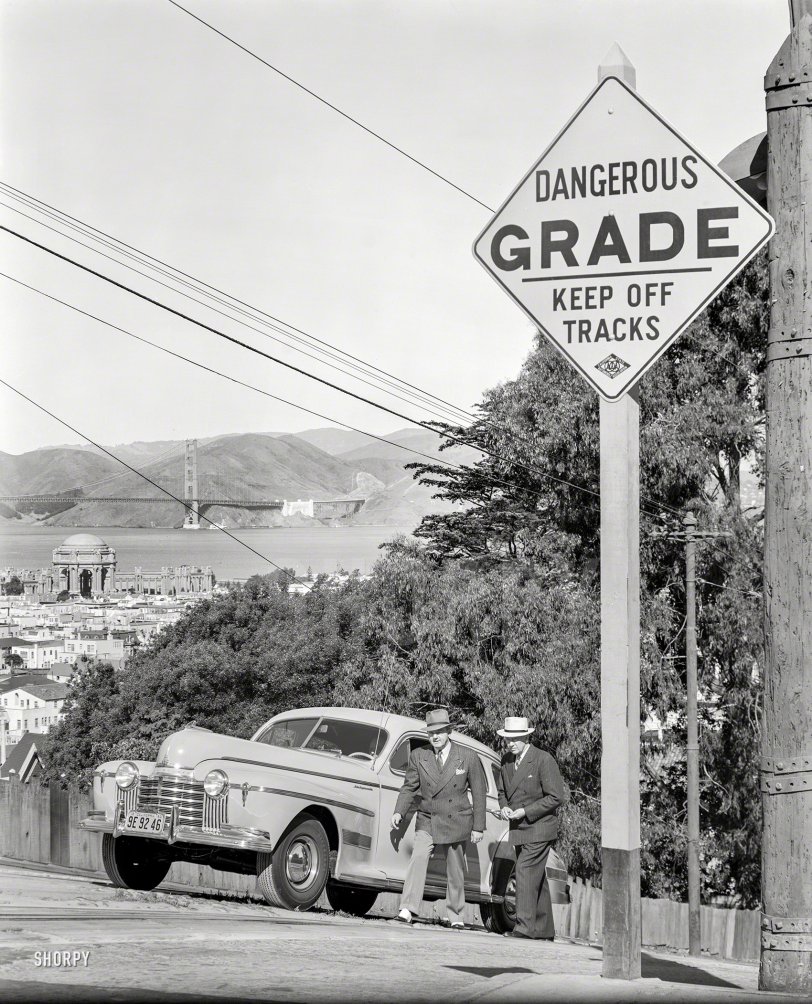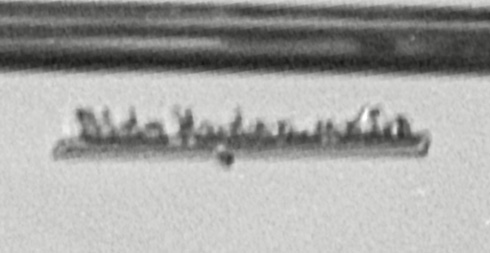


Framed or unframed, desk size to sofa size, printed by us in Arizona and Alabama since 2007. Explore now.
Shorpy is funded by you. Patreon contributors get an ad-free experience.
Learn more.

- Baldwin 62303
- Baldwin VO-1000
- Cold
- No expense spared
- Tough Guys
- Lost in Toyland
- And without gloves
- If I were a blindfolded time traveler
- Smoke Consumer Also Cooks
- Oh that stove!
- Possibly still there?
- What?!?
- $100 Reward
- Freeze Frame
- Texas Flyer wanted
- Just a Year Too Soon
- WWII -- Replacing men with women at the railroad crossing.
- Yes, Icing
- You kids drive me nuts!
- NOT An Easy Job
- I wonder
- Just add window boxes
- Icing Platform?
- Indiana Harbor Belt abides
- Freezing haze
- Corrections (for those who care)
- C&NW at Nelson
- Fallen Flags
- A dangerous job made worse
- Water Stop
Print Emporium
Upward Oldsmobile: 1940

San Francisco, 1940. "Oldsmobile sedan and pedestrians ascending steep grade." With the Palace of Fine Arts and Golden Gate Bridge in the distance. 8x0 film negative, originally from the Wyland Stanley collection. View full size.
Fillmore counterbalance
That's a 24% grade on Fillmore, so streetcars couldn't climb it unassisted. They used a counterbalance cable-- a streetcar descending the two blocks from Broadway to Green pulled another car from Green to Broadway. No need for much braking.
After that ended in April 1941 the streetcars only ran south of Broadway.
[More about the Fillmore counterbalance in the comments to this photo, taken at this corner fourteen years earlier. -tterrace]
"Keep off Tracks"
The reasoning behind the sign, is due in no small part to the tendency of the streetcars which operated in this area, to "run away" when going down the hill. Braking was typically done by way of wooden blocks on the car's wheels, and while on most hills this would keep the speed manageable, on this particular location (and a few others of note) it was not uncommon for the brake blocks to ignite from the friction of holding against the wheels. Meaning that passengers would be in for a wild ride, if they were lucky, or a derailment if not. To compensate for this, no stops were on the hill itself, and there were no curves in the line for about a city block, to allow the trains ample time to stop. Typically, their speed was 8 miles per hour when on flat land, though going down hill here, speeds double that were often recorded.
Fillmore St?
Camera must be at Fillmore and Broadway?
[That's the conclusion I came to. -tterrace]
The Company Car
The low-end version of this was the first car I rode in, provided by my father's employer all the way to 1950. The owner's manual was some of my earliest reading. And it probably went up that hill at least once.
Menswear Details
The gentleman in front is wearing a striped double-breasted jacket as a sportcoat - interesting choice. And he is sporting genuine spats, which can't still have been common as late as 1940.
Keep Off Tracks
The driver of the Olds seems to be obeying that rule since the car appears not to be on the tracks, but between them.
[Lack of traction on the rails was the reason for the warning. -tterrace]
Model Year 1941
So we're looking at some time after September, I should think.
My father bought one of these when he got back from the Pacific in '45, new cars being almost unobtainable, and I have always thought this model a triumph of immediate pre-war styling. I recall many happy miles standing on the front seat between my parents as my father wended his aggressive way from point to point.
Really, it is a miracle that anyone of my generation survived to adulthood.
Hill Holder
I don't know if this Olds had it, but Bendix made an accessory called a "Hill Holder" that would keep manual transmissions from rolling backwards when starting on steep hills like here and in Duluth MN. My dad's 51 Studebaker had it, and surprisingly my son in law's new Jeep Wrangler has it. In the day, they were also available in the after-market.
It got away from the two foot-three pedal dance needed to start a car stopped on a steep hill without rolling back into the car behind you.
[This car has an automatic transmission, and just two pedals. - Dave]

























On Shorpy:
Today’s Top 5